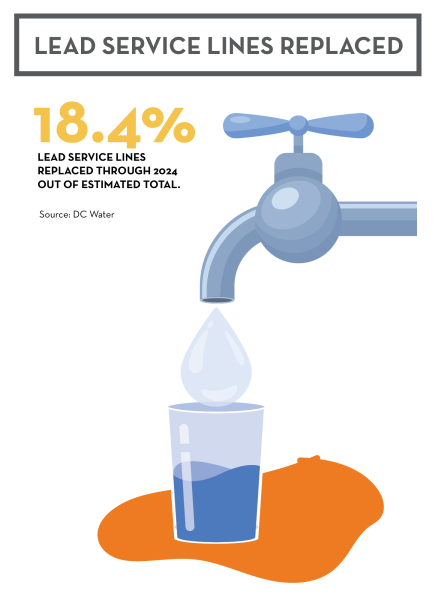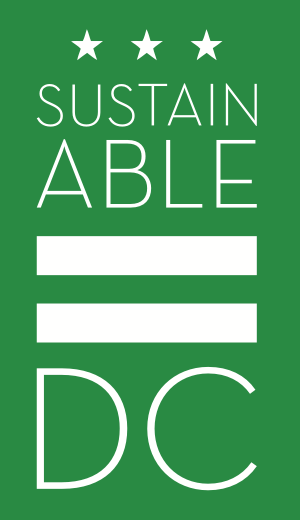

 Water plays an integral role in all aspects of life in the District. Located at the confluence of the Anacostia and Potomac rivers, the District of Columbia has 47 miles of shoreline. Healthy local and regional waterways are the foundation for safe drinking water, sustenance through fishing, swimming and recreation, and habitat and quality of life for the District’s wildlife. While the District’s waterways have started to make a remarkable comeback, there is still much room for improvement. Innovative technologies and programs—such as new underground tunnels to reduce combined sewer overflows, incentives to install green infrastructure and remove impervious surfaces, lead pipe replacement, and remediation work for contaminated sediments—all help us get there.
Water plays an integral role in all aspects of life in the District. Located at the confluence of the Anacostia and Potomac rivers, the District of Columbia has 47 miles of shoreline. Healthy local and regional waterways are the foundation for safe drinking water, sustenance through fishing, swimming and recreation, and habitat and quality of life for the District’s wildlife. While the District’s waterways have started to make a remarkable comeback, there is still much room for improvement. Innovative technologies and programs—such as new underground tunnels to reduce combined sewer overflows, incentives to install green infrastructure and remove impervious surfaces, lead pipe replacement, and remediation work for contaminated sediments—all help us get there.
Goal 1: Improve the quality of waterways to standards suitable for fishing and swimming
Status:  The average progress score of actions under this goal is between “Moderate Progress” (2 out of 4) and “Significant Progress” (3 out of 4). See annual progress reports for details.
The average progress score of actions under this goal is between “Moderate Progress” (2 out of 4) and “Significant Progress” (3 out of 4). See annual progress reports for details.
What's Been Done?
- The Anacostia River Tunnel System went into service, helping reduce combined sewer overflows to the Anacostia River by 98 percent in an average year.
- The Department of Energy and Environment initiated a volunteer-based citizen science initiative in 2018 to collect and analyze more water samples.
- The Water Quality Data Dashboard from the Department of Energy and Environment became available to the public in 2023 and includes data on ambient water quality, fish tissue studies, and more.
- In 2019, the District Snow Team (staff from Department of Public Works, Department of Energy and Environment, and the District Department of Transportation) developed and executed a salt reduction pilot to deploy Calcium Magnesium Acetate, an eco-friendly form of ice melt.
What is Left to Do?
- Encourage reduced use of personal care products, pesticides, and fertilizers that contain existing and emerging contaminants.
- Create and adopt a salt management strategy for snow and ice removal that minimizes the use of road salt, and study alternatives to reduce Washington, DC’s reliance on road salt.
- Develop and implement an Anacostia River remediation work plan that restores fish and wildlife habitat while improving public access to the river.
- Increase public access to water quality monitoring data for public waterways and develop partnerships to expand the scope of water quality monitoring.
- Restore 10 miles of streams in the District.
Goal 2: Reduce the volume of stormwater runoff
Status:  The average progress score of actions under this goal is between “Moderate Progress” (2 out of 4) and “Significant Progress” (3 out of 4). See annual progress reports for details.
The average progress score of actions under this goal is between “Moderate Progress” (2 out of 4) and “Significant Progress” (3 out of 4). See annual progress reports for details.
What's Been Done?
- The Department of Energy and Environment’s RiverSmart programs help reduce stormwater runoff that harms the District’s waterways and the Chesapeake Bay through financial incentives for green infrastructure such as rain barrels, green roofs, rain gardens, permeable pavers, shade trees, and more.
- In 2019, the District Snow Team (staff from Department of Public Works, Department of Energy and Environment, and the District Department of Transportation) developed and executed a salt reduction pilot to deploy Calcium Magnesium Acetate, an eco-friendly form of ice melt.
- In 2023, the Department of Energy and Environment’s Stormwater Retention Credit (SRC) Trading program, which began in 2013, surpassed 2 million SRCs traded, demonstrating significant investment in green infrastructure across the District.
- The District has more than 6.25 million square feet of green roof installed.
- The District Department of Transportation has installed community-scale green infrastructure projects to reduce the amount of pollution and stormwater volumes of water entering District waterways all around the District, including in LeDroit Park and Klingle Valley Trail.
What is Left to Do?
- Audit 1,200 properties per year via the RiverSmart Homes program and increase participation in areas of the city where enrollment has been historically low.
- Incorporate neighborhood-scale stormwater collection into largescale planning efforts early in the redevelopment process, including public right of way and parks.
- Grow the Stormwater Retention Credit Trading program.
- Streamline and coordinate incentive programs for combined green roofs and solar projects.
- Pilot a large scale network of green infrastructure with smart controls to better understand performance and inform future project designs.
Goal 3: Reduce demands for potable water and increase rainwater reuse
Status:  The average progress score of actions under this goal is between “Initiated” (1 out of 4) and “Moderate Progress” (2 out of 4). See annual progress reports for details.
The average progress score of actions under this goal is between “Initiated” (1 out of 4) and “Moderate Progress” (2 out of 4). See annual progress reports for details.
What's Been Done?
- The 2017 DC Green Construction Code include improved water efficiency requirements, as do the alternative compliance pathways to the Energy and Green Construction Codes.
- DC Water provides an incentive for water conservation in their rate structure by offering a discount to household customers for the first four hundred cubic feet of water used.
What is Left to Do?
- Update the District building codes to increase water-efficiency standards and allow the use of alternative water systems.
- Develop incentives for water-efficiency measures in landscaping and buildings.
- Pilot water efficiency projects in the District Government to lead by example.
Goal 4: Ensure safe, accessible drinking water
Status:  The average progress score of actions under this goal is between “Initiated” (1 out of 4) and “Moderate Progress” (2 out of 4). See annual progress reports for details.
The average progress score of actions under this goal is between “Initiated” (1 out of 4) and “Moderate Progress” (2 out of 4). See annual progress reports for details.
What's Been Done?
- DC Water launched the Lead Free DC Initiative in 2019 to accelerate lead service line replacement and combine all its lead reduction efforts under one banner.
- DC Water is constructing a floodwall to protect the Blue Plains Advanced Treatment Plant from being inundated in a 500-year flood event. About half of the floodwall has been completed.
What is Left to Do?
- Identify and implement the most effective steps to improve the resilience of the drinking water system to natural and human disasters.
- Eliminate all lead service lines and plumbing from District Government-owned buildings.
- Replace at least 1% of water pipes each year.
- Work with the Washington Aqueduct to ensure that the District’s drinking water is of the highest possible quality by protecting source water, addressing emerging contaminants, and upgrading drinking water treatment processes.
Last updated: June 2025

